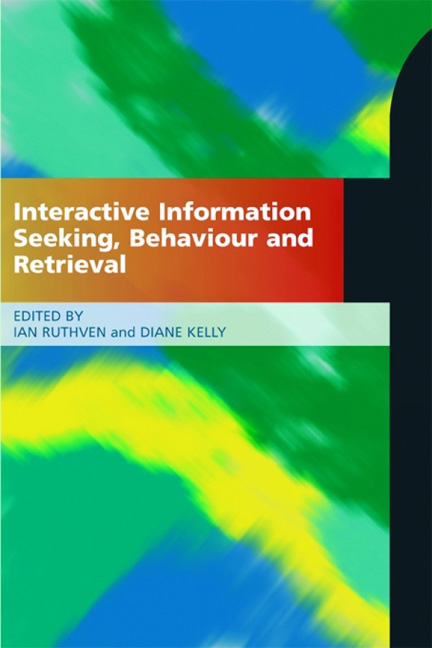Book contents
- Frontmatter
- Dedication
- Contents
- Figures and tables: acknowledgements
- Contributors
- Foreword
- Preface
- 1 Interactive information retrieval: history and background
- 2 Information behavior and seeking
- 3 Task-based information searching and retrieval
- 4 Approaches to investigating information interaction and behaviour
- 5 Information representation
- 6 Access models
- 7 Evaluation
- 8 Interfaces for information retrieval
- 9 Interactive techniques
- 10 Web retrieval, ranking and personalization
- 11 Recommendation, collaboration and social search
- 12 Multimedia: behaviour, interfaces and interaction
- 13 Multimedia: information representation and access
- References
- Index
1 - Interactive information retrieval: history and background
Published online by Cambridge University Press: 08 June 2018
- Frontmatter
- Dedication
- Contents
- Figures and tables: acknowledgements
- Contributors
- Foreword
- Preface
- 1 Interactive information retrieval: history and background
- 2 Information behavior and seeking
- 3 Task-based information searching and retrieval
- 4 Approaches to investigating information interaction and behaviour
- 5 Information representation
- 6 Access models
- 7 Evaluation
- 8 Interfaces for information retrieval
- 9 Interactive techniques
- 10 Web retrieval, ranking and personalization
- 11 Recommendation, collaboration and social search
- 12 Multimedia: behaviour, interfaces and interaction
- 13 Multimedia: information representation and access
- References
- Index
Summary
Why interactive information retrieval and not just information retrieval?
It is legitimate for the reader to ask why a distinction is made by this book between the terms ‘interactive information retrieval’ and ‘information retrieval’. Surely, in the current context of information seeking through web search engines, it is clear that information retrieval necessarily involves some form of interaction between searcher and system. An answer to this question lies in the early history of computerized information retrieval systems, especially in their evaluation as carried out by different disciplinary groups.
If we consider libraries as prototypical information retrieval systems, we can see one aspect of their history as moving from ‘closed stack’ libraries, in which the information seeker can interact with the information objects in the collection only through some intermediary who controls access to those objects, to ‘open stack’ libraries, in which the information seeker is able to interact directly with the information objects (although, of course, often with the benefit of an inter - mediary's assistance, and in both cases usually with the benefit of some ordering of the collection, and/or of some index to it). From this point of view, we can see at least three ways in which interaction in the information retrieval system occurs: between the information seeker and an intermediary; between the intermediary and the collection; and between the information seeker and the collection. To these three we might also add interaction of information seeker and intermediary with the index to the collection. The goal of all of this interaction is, ultimately, that the information seeker finds the information object(s) that are useful in achieving the goal that led to the information-seeking behavior (cf. Belkin, 2010).
Although the term ‘information retrieval’ was coined in 1950 by C. N. Mooers (Mooers, 1950) it came into general use only in the late 1950s, when computers began to be used for the purposes of automatically characterizing the contents of documents, and retrieving them from document collections. The characterizing of the documents was understood as indexing them (on the example of traditional library and documentation practice), and their retrieval was construed as the characterization of an information seeker's information problem as a query put to the collection, couched in the vocabulary of the indexing language.
- Type
- Chapter
- Information
- Publisher: FacetPrint publication year: 2011
- 3
- Cited by



